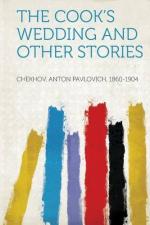From the dining-room there is a door leading into the nursery. There, at a table covered with stains and deep scratches, sits Styopa, a high-school boy in the second class, with a peevish expression of face and tear-stained eyes. With his knees raised almost to his chin, and his hands clasped round them, he is swaying to and fro like a Chinese idol and looking crossly at a sum book.
“Are you working?” asks Pavel Vassilitch, sitting down to the table and yawning. “Yes, my boy. . . . We have enjoyed ourselves, slept, and eaten pancakes, and to-morrow comes Lenten fare, repentance, and going to work. Every period of time has its limits. Why are your eyes so red? Are you sick of learning your lessons? To be sure, after pancakes, lessons are nasty to swallow. That’s about it.”
“What are you laughing at the child for?” Pelageya Ivanovna calls from the next room. “You had better show him instead of laughing at him. He’ll get a one again to-morrow, and make me miserable.”
“What is it you don’t understand?” Pavel Vassilitch asks Styopa.
“Why this . . . division of fractions,” the boy answers crossly. “The division of fractions by fractions. . . .”
“H’m . . . queer boy! What is there in it? There’s nothing to understand in it. Learn the rules, and that’s all. . . . To divide a fraction by a fraction you must multiply the numerator of the first fraction by the denominator of the second, and that will be the numerator of the quotient. . . . In this case, the numerator of the first fraction. . . .”
“I know that without your telling me,” Styopa interrupts him, flicking a walnut shell off the table. “Show me the proof.”
“The proof? Very well, give me a pencil. Listen. . . . Suppose we want to divide seven eighths by two fifths. Well, the point of it is, my boy, that it’s required to divide these fractions by each other. . . . Have they set the samovar?”
“I don’t know.”
“It’s time for tea. . . . It’s past seven. Well, now listen. We will look at it like this. . . . Suppose we want to divide seven eighths not by two fifths but by two, that is, by the numerator only. We divide it, what do we get?
“Seven sixteenths.”
“Right. Bravo! Well, the trick of it is, my boy, that if we . . . so if we have divided it by two then. . . . Wait a bit, I am getting muddled. I remember when I was at school, the teacher of arithmetic was called Sigismund Urbanitch, a Pole. He used to get into a muddle over every lesson. He would begin explaining some theory, get in a tangle, and turn crimson all over and race up and down the class-room as though someone were sticking an awl in his back, then he would blow his nose half a dozen times and begin to cry. But you know we were magnanimous to him, we pretended not to see it. ’What is it, Sigismund Urbanitch?’ we used to ask him. ‘Have you got toothache?’ And what a set of young ruffians, regular cut-throats,




